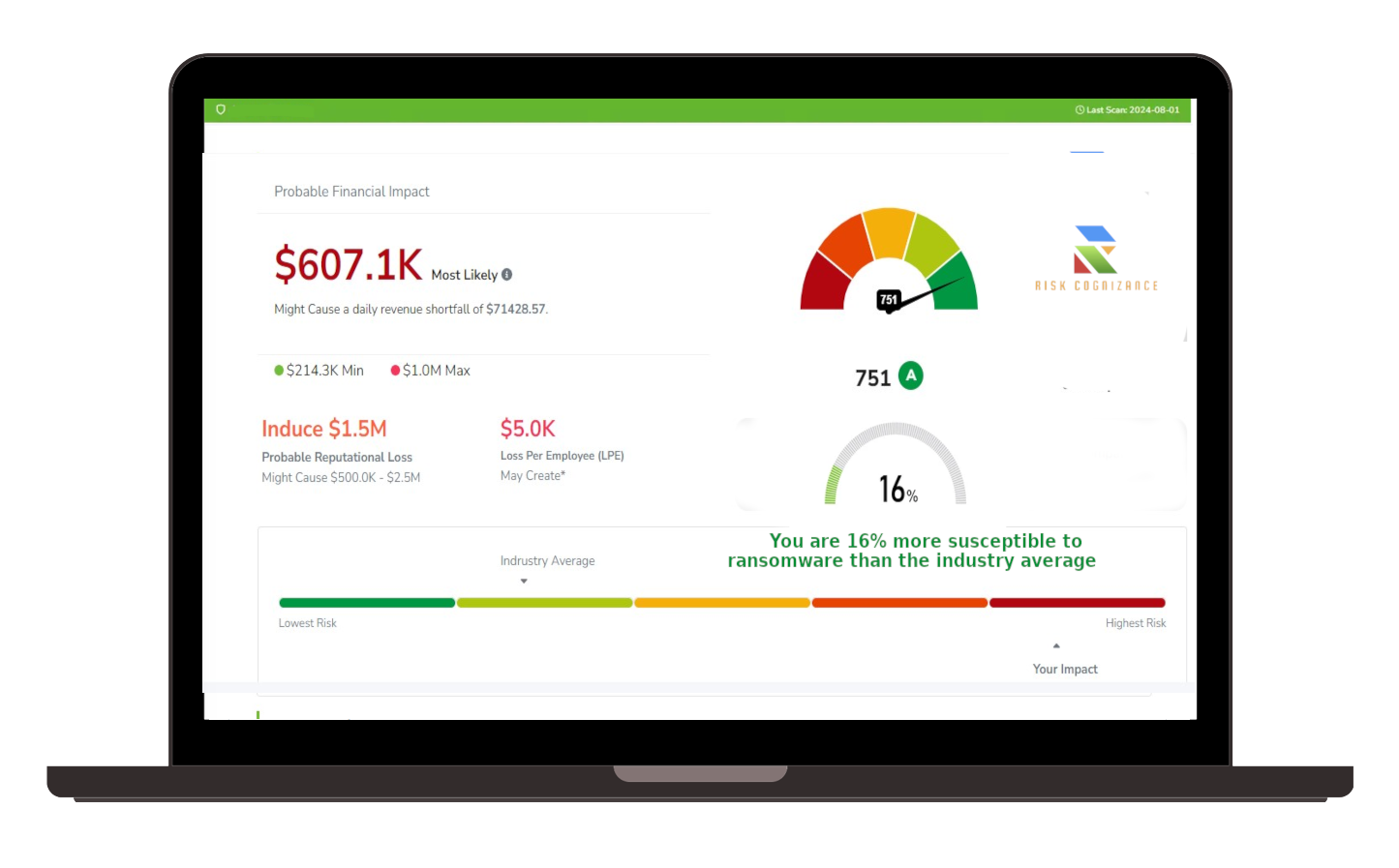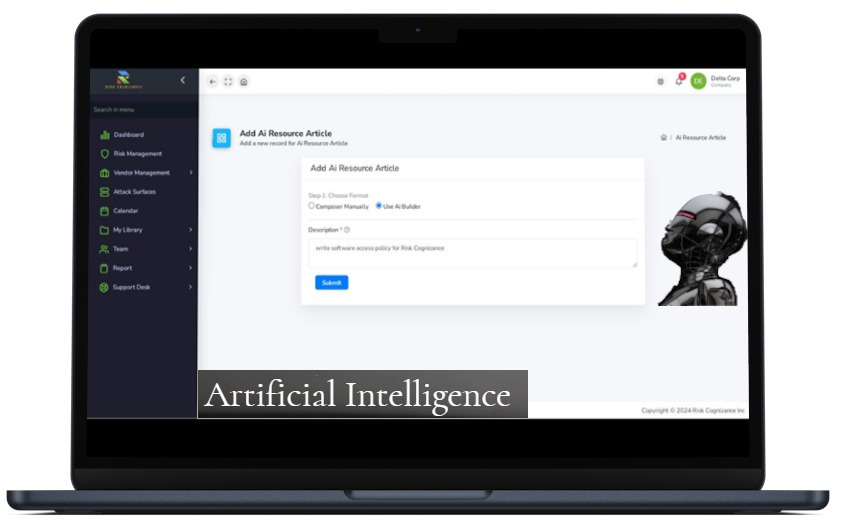Overview
Risk Cognizance provides organizations with advanced, AI-driven tools to navigate the complexities of regulatory compliance and risk management. With a focus on key standards such as NIST, ISO 27001, HIPAA, SOX, GDPR, CCPA, and SOC 2, Risk Cognizance enhances six core risk assessment methodologies, incorporating third-party risk, attack surface risk, and vulnerability risk.
1. Qualitative Risk Assessment
Qualitative risk assessment evaluates risks based on their severity and likelihood using non-numerical data, making it ideal for frameworks like NIST and ISO 27001. This approach is crucial for understanding and managing risks related to information security, third-party vendors, and vulnerabilities.
How Risk Cognizance Enhances This Method:
- Provides templates for categorizing risks related to third-party vendors, attack surfaces, and vulnerabilities aligned with NIST and ISO 27001.
- Facilitates compliance with HIPAA, SOX, and SOC 2 by enabling comprehensive risk documentation.
- Supports continuous monitoring to ensure ongoing alignment with GDPR and CCPA requirements, particularly in managing third-party risks and potential vulnerabilities.
Our Solutions
Enterprise Risk Management Software Streamline your ISO 27001 risk management strategy with a comprehensive view of internal and external cyber risks. Third Party Risk Management Platform Continuously assess and manage the ISO 27001 risks of your external partners with integrated live data for precise risk monitoring. These findings validate questionnaires responses for questionnaire management. Cyber Risk Management Platform Prioritize and manage cybersecurity threats effectively with our Vulnerability Prioritization tools, focusing on identifying and mitigating the most critical vulnerabilities in your network. | Obtain clear, data-driven Security Ratings to assess and enhance your ISO 27001 compliance performance, providing an accurate representation of your organization’s security posture. Attack Surface Management Platform Reduce cyber vulnerabilities through our comprehensive Attack Surface Management, identifying and securing potential threat entry points across your network. Safeguard your organization’s internal networks and systems. With options for both agent and agentless security scanning, we ensure flexible and thorough assessment of cyber risks within your infrastructure. |
 Compliance (GRC) Software ISO 27000 Platform |  |
 |  |
| |
2. Quantitative Risk Assessment
This methodology assigns numerical values to risks, including financial impacts, and is vital for compliance with SOX, HIPAA, and SOC 2. Quantitative assessments are particularly valuable when assessing the financial implications of third-party risks, attack surface vulnerabilities, and overall risk exposure.
How Risk Cognizance Enhances This Method:
- Integrates financial modeling tools for assessing third-party risk and attack surface vulnerabilities under SOX compliance.
- Uses AI to analyze data for GDPR and CCPA impact assessments related to external vendors and attack surfaces.
- Provides dashboards that quantify risks to HIPAA and ISO 27001 standards, incorporating third-party and vulnerability assessments.
- Offers simulations to predict financial impacts of risks, including those related to third-party vendors and vulnerabilities.
3. Scenario Analysis
Scenario analysis explores different future states to assess how risks may evolve, particularly in dynamic regulatory environments. With Risk Cognizance, organizations can create scenarios that consider changes in third-party relationships, attack surface expansions, and emerging vulnerabilities within the context of GDPR, CCPA, and HIPAA compliance.
How Risk Cognizance Enhances This Method:
- Supports scenario planning for future regulatory changes and third-party risk management aligned with NIST and ISO 27001.
- Helps model the impact of potential breaches on HIPAA compliance, including vulnerabilities in third-party vendors.
- Facilitates GDPR and CCPA compliance scenarios that evaluate privacy risks associated with third-party vendors and attack surface exposure.
- Provides visual comparisons of scenarios, aiding decision-making in SOX and SOC 2 contexts, especially concerning third-party and vulnerability risks.
4. Failure Mode and Effects Analysis (FMEA)
FMEA identifies potential failure points in systems, which is critical for minimizing risks to information security under ISO 27001. Risk Cognizance automates FMEA processes, ensuring that third-party risks, attack surface vulnerabilities, and overall system weaknesses are addressed before they lead to compliance breaches.
How Risk Cognizance Enhances This Method:
- Automates FMEA processes to align with ISO 27001 and NIST, focusing on third-party vendors and attack surface vulnerabilities.
- Documents potential failures and their impacts on HIPAA, SOX, and SOC 2 compliance.
- Identifies and prioritizes risks related to third-party vendors and vulnerabilities, impacting GDPR and CCPA compliance.
- Integrates FMEA with other risk management tools for comprehensive analysis of third-party and vulnerability risks.
5. Root Cause Analysis (RCA)
RCA identifies the underlying causes of incidents or risks, crucial for maintaining compliance with SOC 2, HIPAA, and ISO 27001. By addressing the root causes of third-party risks, attack surface vulnerabilities, and other security issues, organizations can prevent future compliance breaches.
How Risk Cognizance Enhances This Method:
- Provides tools for conducting RCA in line with SOC 2, HIPAA, and ISO 27001 standards, focusing on third-party and vulnerability risks.
- Facilitates documentation of findings for compliance reporting under SOX and GDPR, addressing root causes in third-party and attack surface vulnerabilities.
- Supports corrective action planning to address root causes identified in NIST assessments, particularly concerning external vendors and system vulnerabilities.
- Integrates RCA with ongoing monitoring for CCPA compliance, ensuring third-party risks and attack surface vulnerabilities are continuously addressed.
6. Bowtie Analysis
Bowtie analysis visually maps out risk pathways, helping organizations understand and manage complex risks, including those related to third-party vendors, attack surfaces, and vulnerabilities. Risk Cognizance enables the creation of bowtie diagrams that demonstrate compliance with NIST, ISO 27001, and GDPR, incorporating third-party risk and vulnerability management.
How Risk Cognizance Enhances This Method:
- Offers tools to create bowtie diagrams aligned with ISO 27001 and NIST, emphasizing third-party risk and vulnerability pathways.
- Visualizes risk pathways impacting SOC 2, HIPAA, and GDPR compliance, including third-party vendors and attack surface vulnerabilities.
- Identifies and documents controls to mitigate risks in SOX and CCPA environments, focusing on third-party and vulnerability risks.
- Provides a comprehensive view of risks, controls, and consequences for compliance reporting, ensuring third-party risks and vulnerabilities are managed effectively.
Why Choose Risk Cognizance for Compliance and Risk Assessment?
Risk Cognizance’s platform is designed to help organizations meet the stringent requirements of NIST, ISO 27001, HIPAA, SOX, GDPR, CCPA, and SOC 2, with a particular focus on managing third-party risks, attack surface vulnerabilities, and overall risk exposure. By leveraging AI-driven tools and comprehensive risk assessment methodologies, Risk Cognizance ensures proactive management of risks while maintaining compliance with critical regulatory standards.
Request Callback


